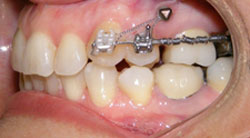
A temporary anchorage device (or TAD) is a very small screw that can be placed inside a patient’s mouth to provide a rigid point of anchorage. They typically are 6mm to 10 mm long and they are made out of titanium metal which is a biologically inert material that will not corrode in the mouth or be rejected by the body. They are designed to hold firmly in the bones of the jaws and be compatible with the gum tissue through which they pass.
TAD’s are sometimes necessary in cases where a patient’s teeth need to be moved in a certain way to get the results that we want. For example, when a tooth is extracted prior to orthodontic treatment due to crowding in that area of the mouth, the teeth on either side of the extracted tooth move toward each other to close the space. This movement between teeth is based on one of the laws of physics that states that “for every action there is an equal and opposite reaction”. However, if a patient has a severe overbite and an upper tooth is extracted on each side of the mouth to make room to move the upper front teeth back, we need to maximize that backward movement to correct the severe overbite. In order to accomplish this, we need to anchor the upper back teeth so that all of the movement comes from the upper front teeth. That’s where TAD’s come into play!
The placement of a TAD is very simple and painless. We typically place a topical anesthetic on the gum tissue overlying where the TAD will be placed. The gum tissue is the only part of the mouth that can feel anything because there is no innervation within bone itself. As long as the gum tissue is numb, the procedure will be completely painless. A driver that is similar to a screwdriver is used to drive the TAD through the gum and into the bone. Insertion takes less than a minute in most cases. TAD’s are usually placed between the roots of two adjacent teeth. In the rare case of root damage, roots will typically repair themselves without issue. When it is time for the TAD to be removed, anesthesia is rarely even needed. It’s that easy!
After a TAD is in place, it provides an immovable object that can be used to pull, push, intrude or extrude teeth that are being straightened. The only requirement is that patients keep the gum tissue around the TAD clean and healthy. In addition to routine brushing, a mouth rinse such as chlorhexidine should be used on a regular basis until the TAD is removed. As long as the gums are kept healthy, there are very few complications that can arise from a TAD.
There are many advantages to utilizing TAD’s during orthodontic treatment. Since TAD’s don’t move, orthodontists can use them to move teeth in directions and amounts that previously were not possible. TAD’s are comfortable, they can reduce treatment time, they can help to improve esthetics, they reduce reliance on patient cooperation such as wearing a headgear, they sometimes can eliminate the need for jaw surgery, they enable us to move and place teeth into healthy positions that otherwise would not be possible and they can help close spaces more efficiently. Orthodontics has a come a very long way in the last 10 to 20 years. Temporary anchorage devices are one of many new and exciting innovations that make orthodontic treatment more desirable and efficient to both children and adults!
By Dr. Gary Reichhold
JAN

About the Author:
Dr. Gary Reichhold and his partner Dr. Stephen Tanner have been proudly serving families in Concord, Walnut Creek, Clayton, Pleasant Hill and the surrounding communities for over 20 years. Their office is conveniently located in central Contra Costa County and their experienced team is committed to providing you and your family with exceptional orthodontic care.